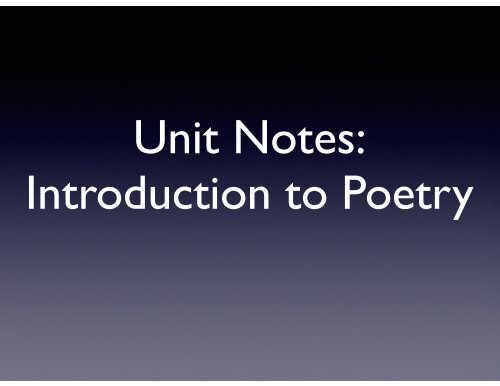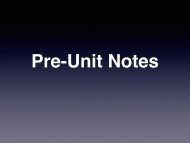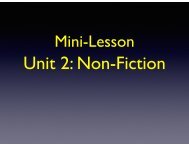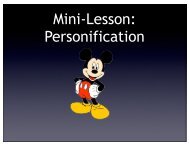Unit Notes Introduction to Poetry
h4bys7j
h4bys7j
Create successful ePaper yourself
Turn your PDF publications into a flip-book with our unique Google optimized e-Paper software.
<strong>Unit</strong> <strong>Notes</strong>:<br />
<strong>Introduction</strong> <strong>to</strong> <strong>Poetry</strong>
What is poetry?<br />
<strong>Poetry</strong> is one of the three major types of literature, the<br />
others being prose and drama. Most poems make use of<br />
highly compact, musical, and emotionally charged<br />
language. Many also make use of imagery, figurative<br />
language, and special devices of sound such as rhyme.<br />
Poems are often divided in<strong>to</strong> lines and stanzas and often<br />
employ regular rhythmical patterns, or meters. <strong>Poetry</strong><br />
that does not follow a regular metrical pattern is called<br />
free verse.
What is poetry?<br />
Think of poetry like paintings. There are paintings that<br />
are classic and easy <strong>to</strong> understand such as a painting of a<br />
valley or a portrait and then there are abstract paintings<br />
that might just be a bunch of colors spattered on a<br />
canvas. They make you feel different and you understand<br />
them differently. You could look at poetry in a similar<br />
way. There are structured poems that rhyme, have a<br />
shape, or a pattern of some sort (and a poem can have<br />
all this or none!). A good poet is really trying <strong>to</strong> make<br />
you feel something when you read it.
Poems are things that are truly expressed in<br />
words that are beautiful.<br />
- Dante<br />
Poems are the best words in the best order.<br />
-Samuel Taylor Coleridge<br />
Poems are the spontaneous overflow of<br />
powerful feelings.<br />
-William Wordsworth<br />
Poems are musical thought.<br />
-Thomas Carlyle
Stanza<br />
An arrangement of a certain number of<br />
lines, two or more, sometimes having a<br />
fixed length, meter, or rhyme scheme,<br />
forming a division of a poem.
“My River Runs <strong>to</strong> Thee” by Emily Dickinson<br />
My river runs <strong>to</strong> thee:<br />
Blue sea, wilt welcome me?<br />
My river waits reply.<br />
Oh sea, look graciously!<br />
I ’ll fetch thee brooks<br />
From spotted nooks,—<br />
Say, sea,<br />
Take me!
Literal Language<br />
Definition: Refers <strong>to</strong> words that do not deviate<br />
from their defined meaning. A literal usage is<br />
the “normal” meanings of the words. Literal<br />
language means exactly what it says.
Figurative Language<br />
Definition: Refers <strong>to</strong> words, and groups of words, that<br />
exaggerate or alter the usual meanings of the<br />
component words for effect. Figurative language is<br />
the opposite of literal language and means<br />
something different <strong>to</strong> (and usually more than) what it<br />
says on the surface.<br />
Example:<br />
He ran fast. (literal language)<br />
He ran like the wind. (figurative language)
The Speaker of the Poem<br />
The speaker is the voice or "persona" of a poem.<br />
One should not assume that the poet is the speaker,<br />
because the poet may be writing from a perspective<br />
entirely different from his own, even with the voice of<br />
another gender, race or species, or even of a<br />
material object. The reader or listener must do more<br />
than just hear the voice of the poem <strong>to</strong> identify the<br />
speaker. It is important <strong>to</strong> examine the other<br />
elements of the poem, such as the situation,<br />
structure, descriptive details, figurative language and<br />
rhythms <strong>to</strong> help determine the speaker’s identity.
Popular Themes & Subjects for <strong>Poetry</strong><br />
love<br />
life<br />
death<br />
relationships<br />
sports<br />
nature<br />
beauty<br />
food<br />
desire<br />
change<br />
friendship<br />
war<br />
women<br />
men<br />
poverty<br />
politics<br />
mothers<br />
fathers<br />
ghosts<br />
illness<br />
rain<br />
snow<br />
s<strong>to</strong>rms<br />
heat<br />
seasons<br />
paradise<br />
education<br />
journeys<br />
freedom<br />
night<br />
day<br />
religion<br />
suicide<br />
birth<br />
loneliness<br />
depression<br />
failure<br />
success<br />
vic<strong>to</strong>ry<br />
loss<br />
moon<br />
stars
Tone & Mood<br />
Tone and mood are NOT the same.<br />
The <strong>to</strong>ne of a piece of literature is the<br />
speaker’s or narra<strong>to</strong>r’s attitude <strong>to</strong>wards<br />
the subject or reader, rather than what<br />
the reader feels, as in mood which is the<br />
general feeling or atmosphere that a<br />
piece of writing creates within the reader.
Tone<br />
Definition: Tone is the attitude(s) <strong>to</strong>ward<br />
the subject and/or audience implied in a<br />
literary work.<br />
Example: A love letter <strong>to</strong> your high school crush<br />
might have a playful, sweet, and romantic <strong>to</strong>ne,<br />
but a letter <strong>to</strong> end the relationship with a<br />
significant other after having found out that they<br />
were cheating on you behind your back will have<br />
a serious, hateful, and angry <strong>to</strong>ne.
IMAGERY
Imagery<br />
An image is a representation of anything we can see,<br />
hear, taste, <strong>to</strong>uch, or smell. A painter or sculp<strong>to</strong>r can<br />
create an image of an apple so true <strong>to</strong> life that we’d<br />
like <strong>to</strong> eat it or feel its weight and roundness in our<br />
hands. A poet, using only words, can make us see,<br />
feel, taste, and smell an apple by describing it as<br />
“rosy,” “shiny,” “heavy,” “mushy,” “sweet.” The<br />
language that appeals <strong>to</strong> our five senses and creates<br />
images in our minds is called imagery.





